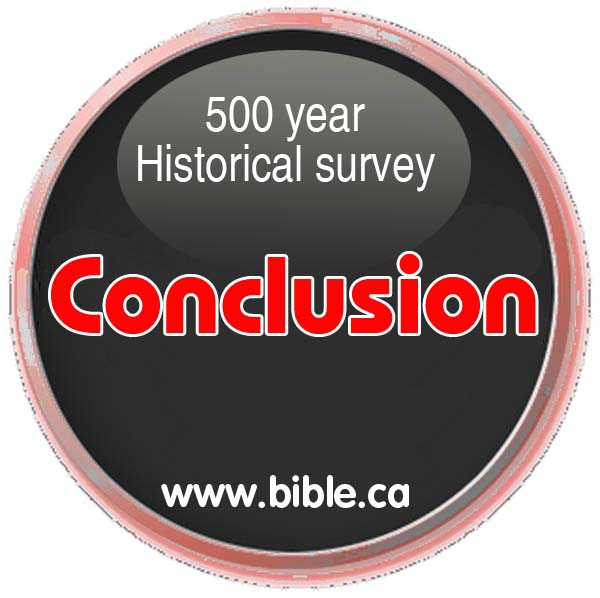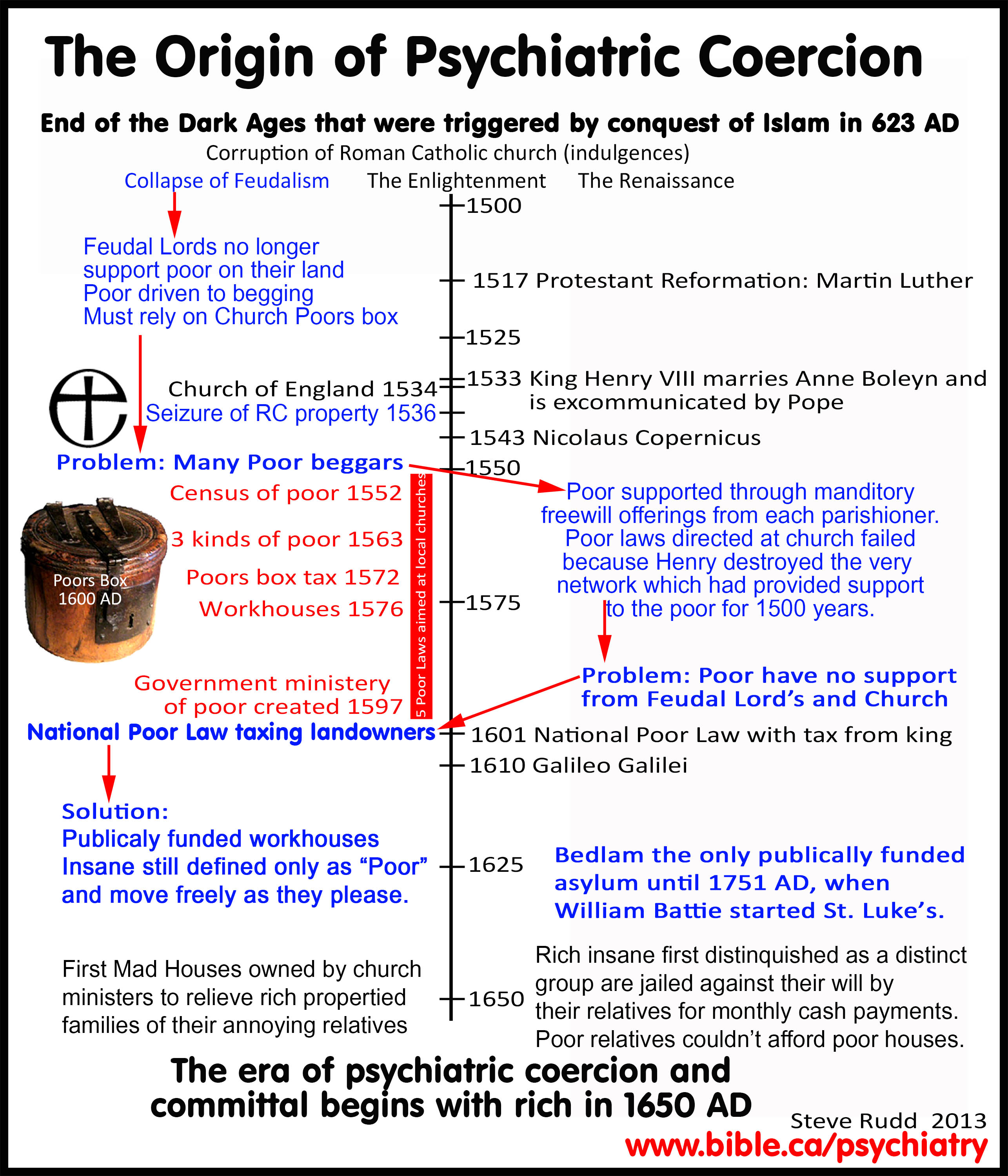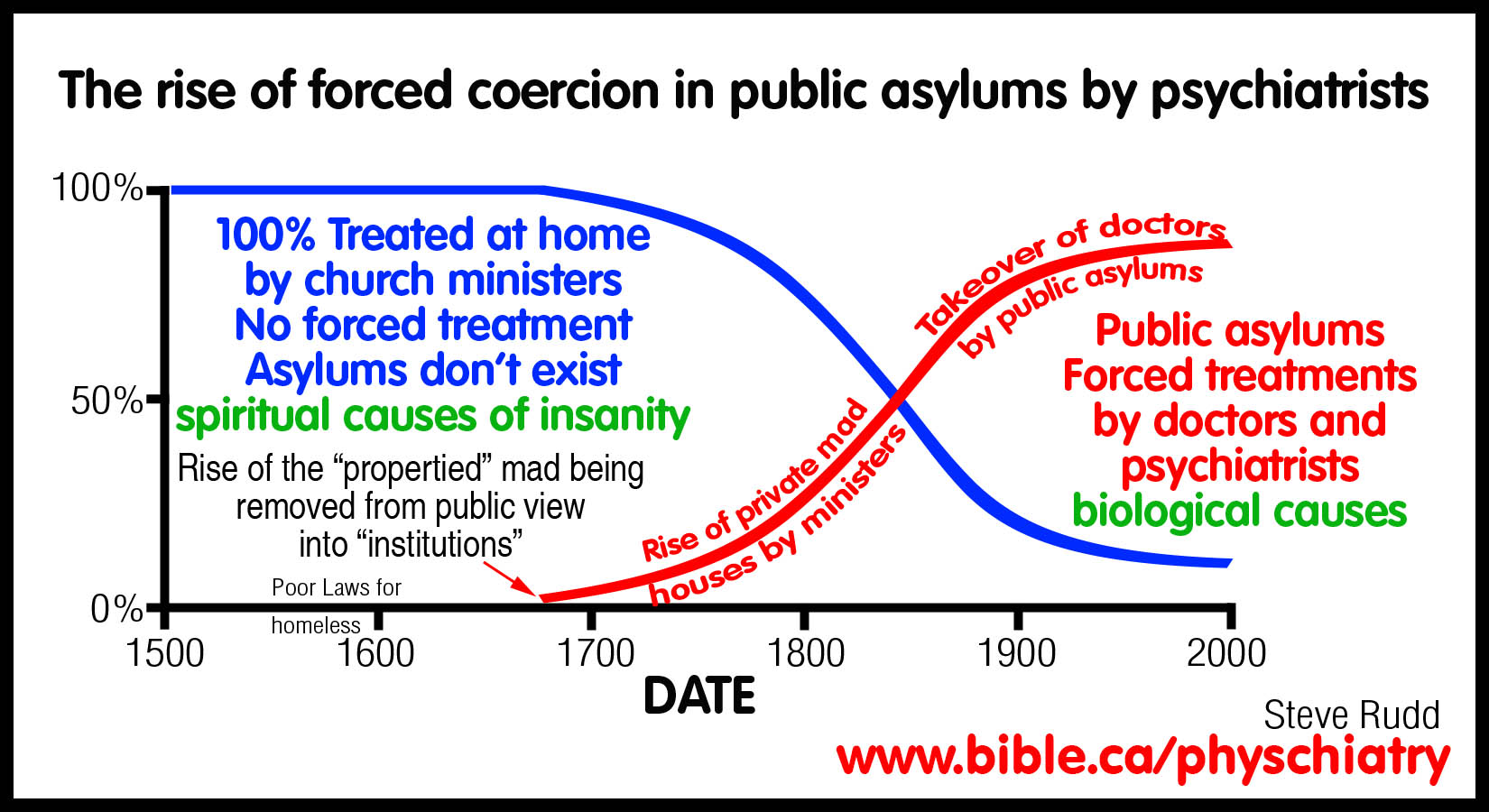Conclusion to the History of Psychiatry:
|
The master conclusion of the 500 year summary of all the historical documents in this section. |
|
|
|
|
||
Master Conclusion to the 500 year historical overview:
The origin of modern psychiatry has its origin in England during the era of King Henry VIII (1509 - 1547).
|
Before 1600 AD, church ministers, not medical doctors, were almost universally considered the experts in correcting the behaviours associated with insanity. The insane were not distinguished from other poor, lazy beggars or violent out of control criminals. Insanity was viewed as a collection of odd or sinful behaviours not a disease. Insanity was believed to be caused by sinful living contrary to the gospel of Jesus Christ and unless the "insane" committed a crime, they were never jailed but instead roamed free throughout the cities and countryside unhindered in spite of their peculiar behaviours. |
The concept of a psychiatric diagnosis was non-existence and people judged the insane on the basis of their words and actions against the moral code of the Bible. A man was not seen as "melancholy or depressed", instead he was rebuked for being lazy and not working. A man was not seen as a "raving madman", instead he was rebuked for having uncontrollable outburst of anger. The insane were held accountable for their all their actions just like everyone else. There was no such thing as "not guilty for reasons of insanity". If you did the crime... you did the time... no exceptions. The poor (which included the insane) could seek help from only three sources: 1. family. 2. their feudal lord. 3. their local "parish" church where they attended.
|
The "poors box" seen in the animated Robin Hood movie, where the church mice gave their last farthing to friar Tuck, is how the poor were supported out of altruistic Christian charity. However, this all changed at the time when King Henry VIII divorced his wife and married Anne Boleyn. The recent collapse of Feudalism drove the poor into the cities as beggars and the Renaissance and the Enlightenment had just dawned. The Roman Catholic church was rife with corruption and indulgences triggered the Protestant Reformation with the aid of Martin Luther. |
When the Pope rightly condemned Henry for divorcing his wife, Henry outlawed the Roman Catholic church in England, ceased all church property and make himself the pope of his new Church of England. This effectively destroyed the ability of the 15,000 "parishes" [local churches] to functioned as a benevolence network to support the poor. With the collapse of feudalism and the destruction of the church, the number of poor beggars in the cities of England skyrocketed and the king was partly to blame! Poor laws were created by Henry's successors that outlawed begging, but provided food and shelter in workhouses - a medieval "work for welfare" program! At first these laws ordered local churches to tax their perisioners to support the work houses via the "poor box", but having just been decimated by King Henry, this was impossible for the churches. The poor law of 1601 AD took a national approach of directly taxing rich landowners to support the poor in workhouses. State welfare was born for the first time. The insane lived undifferentiated from other poor, unemployed beggars in the work houses.
From work houses to Mad houses.
Because church ministers were historically viewed as the exclusive experts in insanity, the families of the rich, propertied upper classes began in about 1650-75 AD, to make direct payments to these church ministers to "board out" their insane relatives in the very first mad houses ... a luxury poor families could not afford. This housing of the rich insane by church ministers marks the historical beginning of psychiatric committal and underscores how all historic mad houses and modern asylums function as a convenience to benefit the relatives of the insane, and not the insane themselves.
By 1700 AD, non-clergyman (doctors and businessmen) saw that privately owned mad houses were a lucrative business and the number of mad houses dramatically increased in number at their hands. Housing the rich propertied insane became a new industry from which church ministers quickly were marginalized. Being completely unregulated, and with church ministers now out of the picture, evil abuses began to occur where sane, (but rebellious) wives were arrested and jailed in private mad houses at the hands of their husbands who made monthly cash payments to the profit seeking mad house owners. Up to about 1750 AD Bedlam was the only publicly funded asylum but after 1800 AD, their number greatly multiplied. In 1774 AD, the Act for Regulating Madhouses (14 George III c. 49) legally excluded church ministers from having anything to do with the process of committal of the insane to an asylum. In fact, church ministers were viewed as being insane themselves, being forbidden to even enter Bedlam. The legal and political takeover of all matters relating to insanity from church ministers by self-seeking doctors had begun. These doctors knew less about medicine than today's 13 year old boy who has dissected a few raccoons on the back porch and played with the chemistry set he got for his birthday. While there were a few doctors and even less preachers, who believed that insanity was caused by "humoral imbalances", the majority view was that insanity was a sinful behaviour, which continued to be the dominant view right up to 1950 AD when the discovery of the first "chemical lobotomy" psychiatric drugs were discovered. All the treatments of the insane at the hands of mad doctors were essentially punitive whose purpose, whether they understood it or not, was to bring about a change of will in the mind of the insane so as to change their unwanted behaviours. Today there is no known biological cause of any mental illness or form of insanity. The concept of a chemical imbalance in the brain is as mythical as it is theoretical, since there is no medical test for depression, anxiety, delusion, paranoia, chronic lying, jealously, anger, spring fever or love sickness. It is impossible for biology to detect behavior patterns in the human body and choices of will, that have their origin in the human spirit.
|
The end of chemical psychiatry gets nearer as biological science progresses. |
Since insanity is a behaviour and not a disease, we today have no advantage over those of the Medieval ages in understanding such behaviors. We need to return to the correct medieval understanding of insanity as a sinful behaviour of choice and that unless a crime is committed, people who sin must not be thrown into asylums against their will for any reason. The insane must be free to live and move among us but must suffer the social consequences of their choices like any other man. The most common behaviours associated with insanity over the last 500 years are selfishness, lack of self control, a desire for dependency and an unwillingness to work. Scripture tells us that if a man will not work, neither let him eat. (2 Thess 3:19) With personal freedom comes personal accountability with personal consequences. Today, asylums and mental hospitals are society's legal solution to controlling those who engage in non-criminal behaviours that are offensive, annoying and cause trouble for others. All psychiatric committal and treatments have always been designed as a way to bring relief to the relatives of the insane (or society in general), with the best interests of the insane taking second place. Asylums are not for the insane, but a way of bringing relief to the relatives of the insane. Inmates inside of asylums always protest about being locked up against their will. Like the "work houses" of Elizabethan England, modern asylums are the institutions that channel state taxed welfare to those who do not want to work, but desire to become dependant, enjoy the personal benefits of drawing a psychiatric disability pension for life, while enjoying the freedom to live and move among the general population as they chose. Nothing has really changed in 500 years. In both medieval times and today, there were those who selfishly refused to work, but instead chose to live off of the hard work of others through begging and state welfare from taxation of those who do work. The "deserving unemployed poor" who lived in the workhouses of 1610 AD, became self sufficient and supported themselves when given the opportunity. It was that third category of the "unwilling to work, poor" that in 1610 AD, found themselves objects of scorn but by the 1800's enjoyed living in comfortable publicly funded asylums. Today, obtaining a psychiatric diagnosis is a well understood method used by those who desire welfare for life, without ever being bothered to find employment. Depression, anxiety, post-traumatic stress disorder, paranoia and hallucination etc., are methods people use as an excuse to escape personal responsibly and an unhappy life circumstance. These have weighed the negative cost of enduring the social stigma of insanity with the positive benefit of doing whatever they want all day long without any accountability. Monthly disability cheques greatly exceed the amount they would make working 8 hours a day, six days a week. Its like the "Cash for Life" lottery, except you are guaranteed to win every time, provided you display a well understood pattern of behaviours in the presence of a psychiatrist who declares you "a winner". Most people are shocked to learn that street people, actually want to live and beg on the streets and have no desire to better themselves and refuse to work if it is offered to them. In this way, the Medieval people correctly ignored insanity as a separate category among those whom they viewed as "the poor". Our 500 year survey of psychiatric history coupled with the most up to date, state of art scientific biological testing, leads us to identify the key that unlocks the mystery of insanity today, namely, that insanity is a behaviour, not a medical disease that these behaviour have their origin in the spirit not the body. The mystery of insanity is solved when we ignore all psychiatric diagnosis' labels and focus on checklisting specific behaviours associated with insanity that are identified in the Bible as sin. Once these behaviours have been identified in a single individual, the only question that needs to be asked is: "What personal benefit does this person derive from engaging in this behaviour". The answer then becomes simple: money, escape responsibility, sympathy, selfishness, attention, control, revenge, rebellion or desire for evil. There is no known biological cause of any mental illness because insanity is not a disease, but a conscious moral choice. The idea of "curing" mental illness is as absurd as the idea of curing laziness, chronic lying, or the desire to do evil. Cures affect the body, information affects the will. You do nor cure a person of who wills to do wrong, you convert them to repentance and obedience to Christ. Just as most individuals reject the call of Christ to be baptized for the remission of their sins, so too the insane reject the call to change their behaviour. When church ministers preach the gospel to sinners, most do not will to change their behaviours. But faith comes by reading the word of God which is capable of bringing about changes in will that are remarkable, dramatic and stunning.
By Steve Rudd: Contact the author for comments, input or corrections.
Send us your story about your experience with modern Psychiatry









